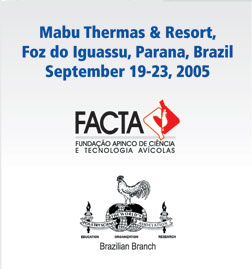PERFORMANCE OF BROILERS USING A LIVE VACCINE AGAINST
AVIAN COCCIDIOSIS
Miguel Angel Müller and Alejandro
Juan José Dubois*
Avian Health and Production Department, College of
Veterinarian Sciences
Universidad Nacional del Litoral, Esperanza - Santa
Fe - Argentina
*Corresponding author. E-mail: alejudubois@hotmail.com
ABSTRACT
Avian Coccidiosis is a parasitic disease which affects
the digestive tract in birds, causing considerably
high economic losses. Anticoccidial drugs, such as
chemicals and ionophores, are administered to prevent
it, but there is a risk of resistance development
by the different Emeria species, and residues are
likely to be present in poultry meat for human consumption,
in addition to many other disadvantages.
Vaccine prophylaxis is an alternative method to control
this disease.
Farm trials were carried out in Argentina on a 500,000
broilers population vaccinated on their first day
of age with Inmunerâ Gel-Coc, by a specially
designed massive application method called “Lluvia
– Gel”. This vaccine aims at the prevention
of Avian Coccidiosis in broilers and is formulated
with live-attenuated oocysts of E. acervulina, E.
brunetti, E. maxima, and E. tenella.
The most important productive parameters were analysed
from an economic point of view and compared to objective
parameters, which were compared with the average performance
indexes obtained during a production year without
using vaccines.
At the same time, successive comparative trials focused
on production were performed. Performance rates reached
in broilers flocks vaccinated with Inmunerâ
Gel-Coc on the first day of age were compared to the
ones obtained in medicated flocks which had received
ionophores or chemical anticoccidial drugs through
the meal.
Performance indexes measured were flock average weight,
feed intake, daily weight gain, feed conversion ratio,
and mortality. Each of them was weekly analyzed.
Simultaneously, systematic and periodic coccidiological
monitoring was carried out in each of these flocks,
as well as and histological studies in order to evaluate
possible anatomic-physiological development and/or
anatomic-pathological changes caused by the replication
of different species of Eimeria in the intestine.
Production data obtained in each of these trials showed
a better performance of the vaccinated groups as compared
to the medicated ones.
Therefore, we conclude that this vaccine against Avian
Coccidiosis does not interfere with the most important
production parameters from an economic point of view.
Moreover, the fact that no Coccidiosis clinical signs
were found in the vaccinated flocks demonstrate the
protective effect of the vaccine and its lack of harmful
effects.
